Effect of Graphene Nanoplatelets Content on the Mechanical and Wear Properties of AZ31 Alloy
Abstract
1. Introduction
2. Materials and Experimental Procedures
2.1. Materials
2.2. Fabrication of GNPs/AZ31 Composites
2.3. Characterization
3. Results and Discussion
3.1. Effect of GNPs on Relative Density and Microstructure
3.2. Effect of GNPs on Mechanical Properties
3.3. Effect of GNPs on Wear Performance
4. Conclusions
Author Contributions
Funding
Acknowledgments
Conflicts of Interest
References
- Pollock, T. Weight Loss with Magnesium Alloys. Science 2010, 328, 986–987. [Google Scholar] [CrossRef] [PubMed]
- Ren, L.; Fan, L.; Zhou, M.; Guo, Y.; Zhang, Y.; Boehlert, C.; Quan, G. Magnesium application in railway rolling stocks: A new challenge and opportunity for lightweighting. Int. J. Light. Mater. Manuf. 2018, 1, 81–88. [Google Scholar] [CrossRef]
- Zhou, M.; Ren, L.; Fan, L.; Zhang, Y.; Lu, T.; Quan, G.; Gupta, M. Progress in research on hybrid metal matrix composites. J. Alloy. Compd. 2020, 838, 155274–155313. [Google Scholar] [CrossRef]
- Shojaeefard, M.H.; Akbari, M.; Asadi, P.; Khalkhali, A. The effect of reinforcement type on the microstructure, mechanical properties, and wear resistance of A356 matrix composites produced by FSP. Int. J. Adv. Manuf. Technol. 2016, 91, 1391–1407. [Google Scholar] [CrossRef]
- Canakcı, A.; Arslan, F. Abrasive wear behaviour of B4C particle reinforced Al2024 MMCs. Int. J. Adv. Manuf. Technol. 2012, 63, 785–795. [Google Scholar] [CrossRef]
- Omrani, E.; Moghadam, A.D.; Menezes, P.L.; Rohatgi, P.K. Influences of graphite reinforcement on the tribological properties of self-lubricating aluminum matrix composites for green tribology, sustainability, and energy efficiency—A review. Int. J. Adv. Manuf. Technol. 2015, 83, 325–346. [Google Scholar] [CrossRef]
- Baradeswaran, A.; Perumal, A.E. Wear and mechanical characteristics of Al 7075/graphite composites. Compos. Part B Eng. 2014, 56, 472–476. [Google Scholar] [CrossRef]
- Moghadam, A.D.; Omrani, E.; Menezes, P.L.; Rohatgi, P.K. Mechanical and tribological properties of self-lubricating metal matrix nanocomposites reinforced by carbon nanotubes (CNTs) and grapheme—A review. Compos Part B Eng. 2015, 77, 402–420. [Google Scholar] [CrossRef]
- Tjong, S.C. Recent progress in the development and properties of novel metal matrix nanocomposites reinforced with carbon nanotubes and graphene nanosheets. Mater. Sci. Eng. R Rep. 2013, 74, 281–350. [Google Scholar] [CrossRef]
- Xiang, S.; Gupta, M.; Wang, X.; Wang, L.; Hu, X.; Wu, K. Enhanced overall strength and ductility of magnesium matrix composites by low content of graphene nanoplatelets. Compos. Part A Appl. Sci. Manuf. 2017, 100, 183–193. [Google Scholar] [CrossRef]
- Meng, L.; Hu, X.; Wang, X.; Zhang, C.; Shi, H.; Xiang, Y.; Liu, N.; Wu, K. Graphene nanoplatelets reinforced Mg matrix composite with enhanced mechanical properties by structure construction. Mater. Sci. Eng. A 2018, 733, 414–418. [Google Scholar] [CrossRef]
- Kumar, H.G.P.; Xavior, M.A. Fatigue and Wear Behavior of Al6061–Graphene Composites Synthesized by Powder Metallurgy. Trans. Indian Inst. Met. 2015, 69, 415–419. [Google Scholar] [CrossRef]
- Ghazaly, A.; Seif, B.; Salem, H.G. Mechanical and Tribological Properties of AA2124-Graphene Self Lubricating Nanocomposite. In Light Metals 2013; Springer: Cham, Switzerland, 2016; pp. 411–415. [Google Scholar] [CrossRef]
- Arab, M.; Marashi, S. Effect of graphene nanoplatelets (GNPs) content on improvement of mechanical and tribological properties of AZ31 Mg matrix nanocomposite. Tribol. Int. 2019, 132, 1–10. [Google Scholar] [CrossRef]
- Wu, L.; Wu, R.; Hou, L.; Zhang, J.; Li, M. Microstructure, mechanical properties and wear performance of AZ31 matrix composites reinforced by graphene nanoplatelets(GNPs). J. Alloy. Compd. 2018, 750, 530–536. [Google Scholar] [CrossRef]
- Zhou, M.; Qu, X.; Ren, L.; Fan, L.; Zhang, Y.; Guo, Y.; Quan, G.; Tang, Q.; Liu, B.; Sun, H. The Effects of Carbon Nanotubes on the Mechanical and Wear Properties of AZ31 Alloy. Materials 2017, 10, 1385. [Google Scholar] [CrossRef]
- Li, G.; Xiong, B. Effects of graphene content on microstructures and tensile property of graphene-nanosheets/aluminum composites. J. Alloy. Compd. 2017, 697, 31–36. [Google Scholar] [CrossRef]
- Parizi, M.T.; Ebrahimi, G.; Ezatpour, H. Effect of graphene nanoplatelets content on the microstructural and mechanical properties of AZ80 magnesium alloy. Mater. Sci. Eng. A 2018, 742, 373–389. [Google Scholar] [CrossRef]
- Liu, J.; Yan, H.; Jiang, K. Mechanical properties of graphene platelet-reinforced alumina ceramic composites. Ceram. Int. 2013, 39, 6215–6221. [Google Scholar] [CrossRef]
- Rashad, M.; Pan, F.; Lin, D.; Asif, M. High temperature mechanical behavior of AZ61 magnesium alloy reinforced with graphene nanoplatelets. Mater. Des. 2016, 89, 1242–1250. [Google Scholar] [CrossRef]
- Du, X.; Du, W.; Wang, Z.; Liu, K.; Li, S. Ultra-high strengthening efficiency of graphene nanoplatelets reinforced magnesium matrix composites. Mater. Sci. Eng. A 2018, 711, 633–642. [Google Scholar] [CrossRef]
- Rashad, M.; Pan, F.; Asif, M. Exploring mechanical behavior of Mg–6Zn alloy reinforced with graphene nanoplatelets. Mater. Sci. Eng. A 2016, 649, 263–269. [Google Scholar] [CrossRef]
- Tekumalla, S.; Bibhanshu, N.; Suwas, S.; Gupta, M. Superior ductility in magnesium alloy-based nanocomposites: The crucial role of texture induced by nanoparticles. J. Mater. Sci. 2019, 54, 8711–8718. [Google Scholar] [CrossRef]
- Guo, L.; Chen, Z.; Gao, L. Effects of grain size, texture and twinning on mechanical properties and work-hardening behavior of AZ31 magnesium alloys. Mater. Sci. Eng. A 2011, 528, 8537–8545. [Google Scholar] [CrossRef]
- Huang, X.; Suzuki, K.; Watazu, A.; Shigematsu, I.; Saito, N. Mechanical properties of Mg–Al–Zn alloy with a tilted basal texture obtained by differential speed rolling. Mater. Sci. Eng. A 2008, 488, 214–220. [Google Scholar] [CrossRef]
- Rashad, M.; Pan, F.; Hu, H.; Asif, M.; Hussain, S.; She, J. Enhanced tensile properties of magnesium composites reinforced with graphene nanoplatelets. Mater. Sci. Eng. A 2015, 630, 36–44. [Google Scholar] [CrossRef]
- Feng, S.; Guo, Q.; Li, Z.; Fan, G.; Li, Z.; Xiong, D.-B.; Su, Y.; Tan, Z.; Zhang, J.; Zhang, D. Strengthening and toughening mechanisms in graphene-Al nanolaminated composite micro-pillars. Acta Mater. 2017, 125, 98–108. [Google Scholar] [CrossRef]
- Yang, M.; Liu, Y.; Fan, T.; Zhang, D. Metal-graphene interfaces in epitaxial and bulk systems: A review. Prog. Mater. Sci. 2020, 110, 100652. [Google Scholar] [CrossRef]
- Kim, Y.; Lee, J.; Yeom, M.S.; Shin, J.W.; Kim, H.; Cui, Y.; Kysar, J.W.; Hone, J.; Jung, Y.; Jeon, S.; et al. Strengthening effect of single-atomic-layer graphene in metal-graphene nanolayered composites. Nat. Commun. 2013, 4, 2114. [Google Scholar] [CrossRef]
- Hong, S.H.; Chung, K.H. Effects of vacuum hot pressing parameters on the tensile properties and microstructures of SiC-2124 Al composites. Mater. Sci. Eng. A 1995, 194, 165–170. [Google Scholar] [CrossRef]
- Abdollahi, A.; Alizadeh, A.; Baharvandi, H.R. Comparative studies on the microstructure and mechanical properties of bimodal and trimodal Al2024 based composites. Mater. Sci. Eng. A 2014, 608, 139–148. [Google Scholar] [CrossRef]
- Rashad, M.; Pan, F.; Tang, A.; Lu, Y.; Asif, M.; Hussain, S.; She, J.; Gou, J.; Mao, J. Effect of graphene nanoplatelets (GNPs) addition on strength and ductility of magnesium-titanium alloys. J. Magnes. Alloy. 2013, 1, 242–248. [Google Scholar] [CrossRef]
- Rashad, M.; Pan, F.S.; Tang, A.T.; Asif, M.; Aamir, M. Synergetic effect of graphene nanoplatelets (GNPs) and multi-walled carbon nanotube (MW-CNTs) on mechanical properties of pure magnesium. J. Alloy. Compd. 2014, 603, 111–118. [Google Scholar] [CrossRef]
- Xiang, S.; Wang, X.; Gupta, M.; Wu, K.; Hu, X.; Zheng, M. Graphene nanoplatelets induced heterogeneous bimodal structural magnesium matrix composites with enhanced mechanical properties. Sci. Rep. 2016, 6, 38824. [Google Scholar] [CrossRef]
- Rashad, M.; Pan, F.; Zhang, J.; Asif, M. Use of high energy ball milling to study the role of graphene nanoplatelets and carbon nanotubes reinforced magnesium alloy. J. Alloy. Compd. 2015, 646, 223–232. [Google Scholar] [CrossRef]
- Zhang, Y.; Li, Y.; Song, M.H.; Zhang, X.C. Effect of Graphene Content on Microstructure and Properties of Gr/Cu Composites. Mater. Sci. Forum 2020, 993, 723–729. [Google Scholar] [CrossRef]
- Xu, Z.; Shi, X.; Zhai, W.; Yao, J.; Song, S.; Zhang, Q. Preparation and tribological properties of TiAl matrix composites reinforced by multilayer graphene. Carbon 2014, 67, 168–177. [Google Scholar] [CrossRef]
- Berman, D.; Erdemir, A.; Sumant, A.V. Few layer graphene to reduce wear and friction on sliding steel surfaces. Carbon 2013, 54, 454–459. [Google Scholar] [CrossRef]
- Hidalgo-Manrique, P.; Lei, X.; Xu, R.; Zhou, M.; Kinloch, I.A.; Young, R.J. Copper/graphene composites: A review. J. Mater. Sci. 2019, 54, 12236–12289. [Google Scholar] [CrossRef]
- Rajkumar, K.; Aravindan, S. Tribological behavior of microwave processed copper-nanographite composites. Tribol. Int. 2013, 57, 282–296. [Google Scholar] [CrossRef]
- Archard, J.F. Contact and Rubbing of Flat Surfaces. J. Appl. Phys. 1953, 24, 981. [Google Scholar] [CrossRef]
- Li, J.; Xiong, D. Tribological behavior of graphite-containing nickel-based composite as function of temperature, load and counterface. Wear 2009, 266, 360–367. [Google Scholar] [CrossRef]
- Garcia-Rodriguea, S.; Torres, B.; Maroto, A.; Lopez, J.Z.; Otero, E.; Rama, J. Dry sliding wear behavior of globular AZ91 magnesium alloy and AZ91/SiCp composites. Wear 2017, 390, 1–10. [Google Scholar] [CrossRef]
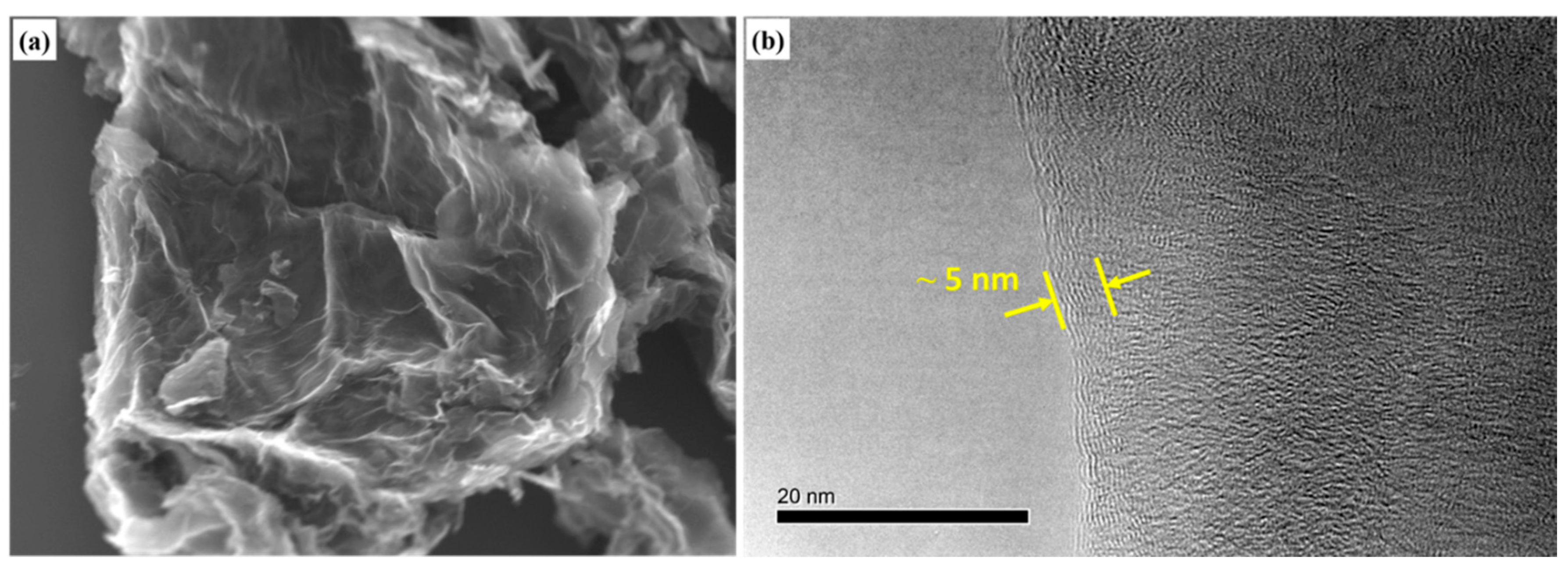
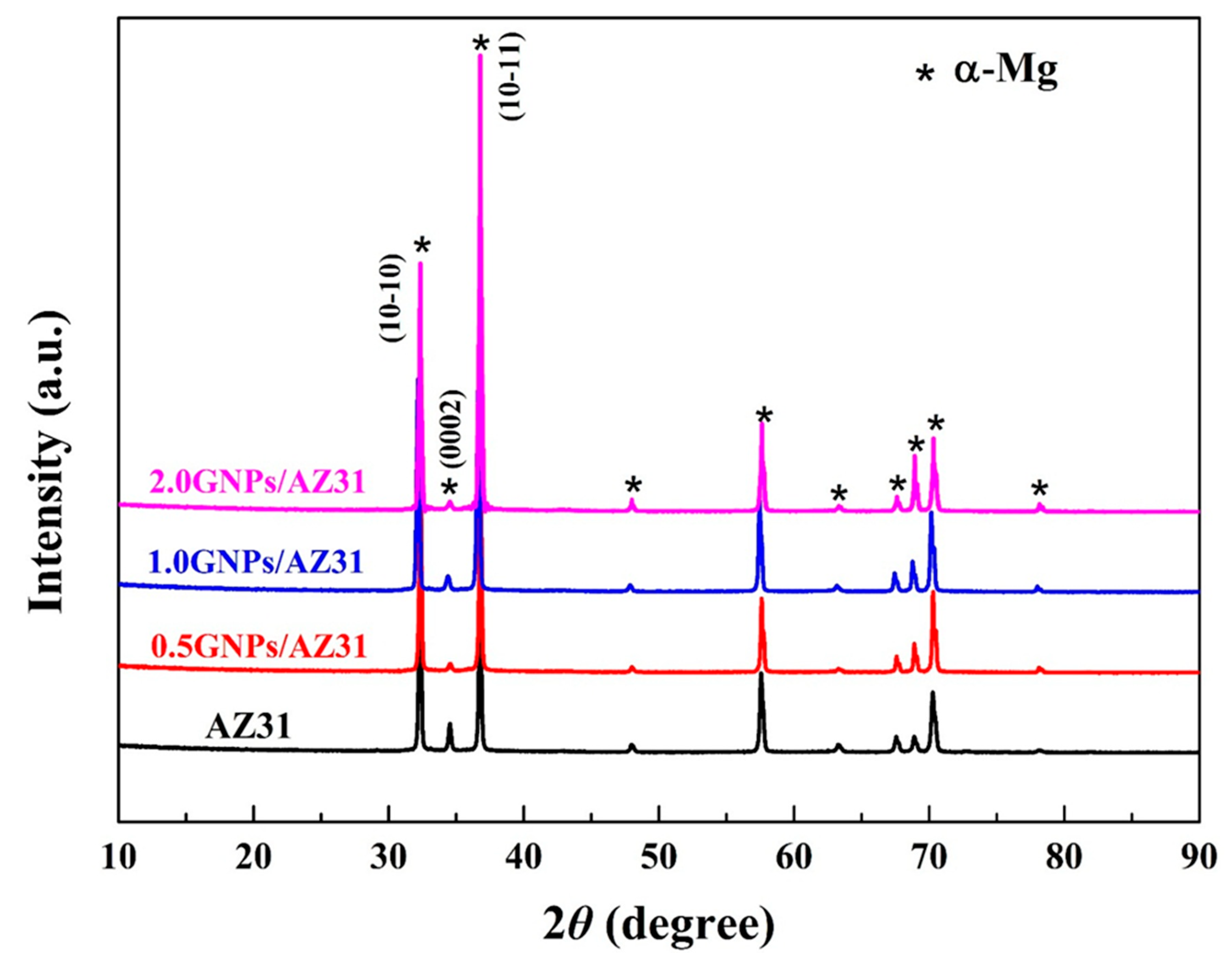
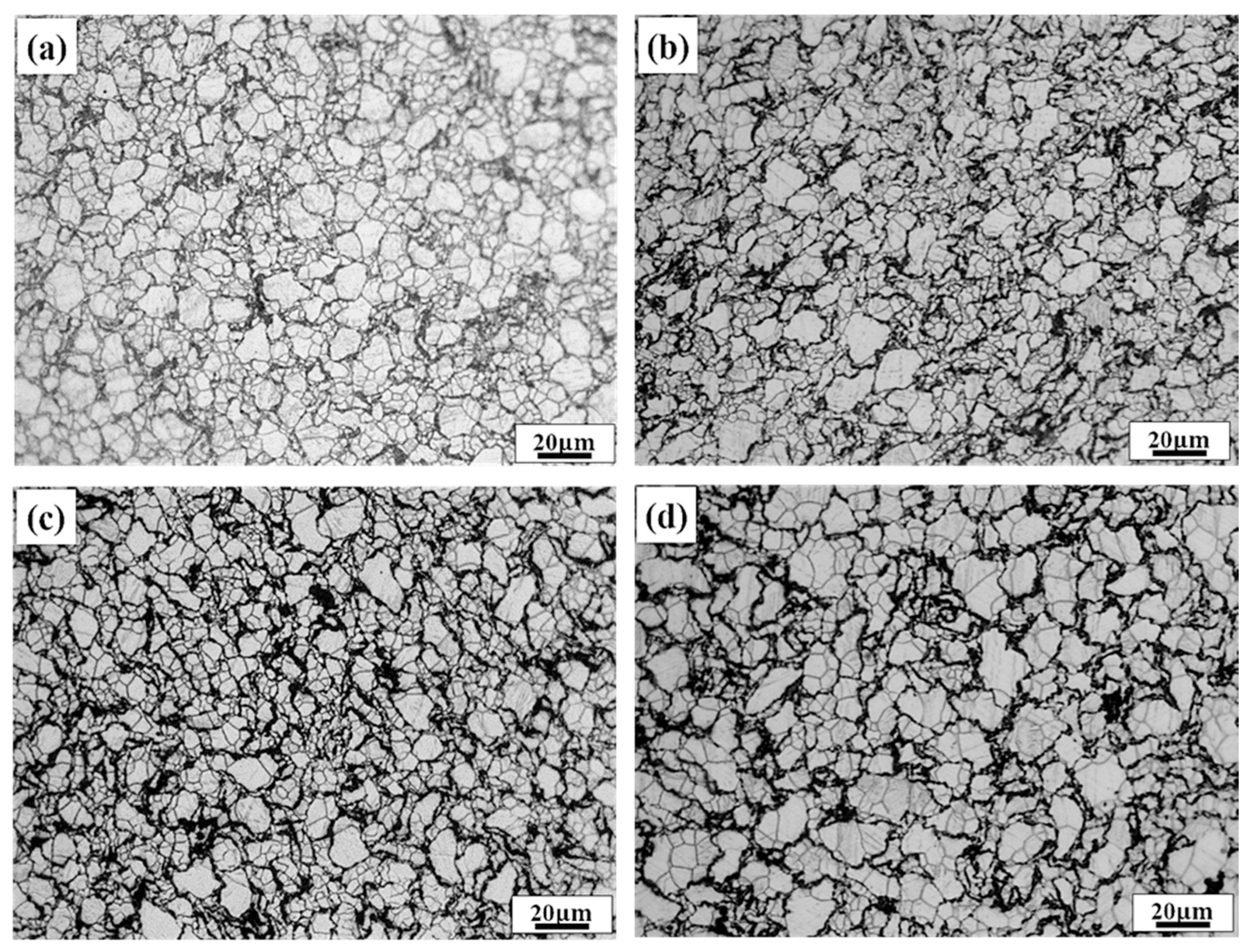
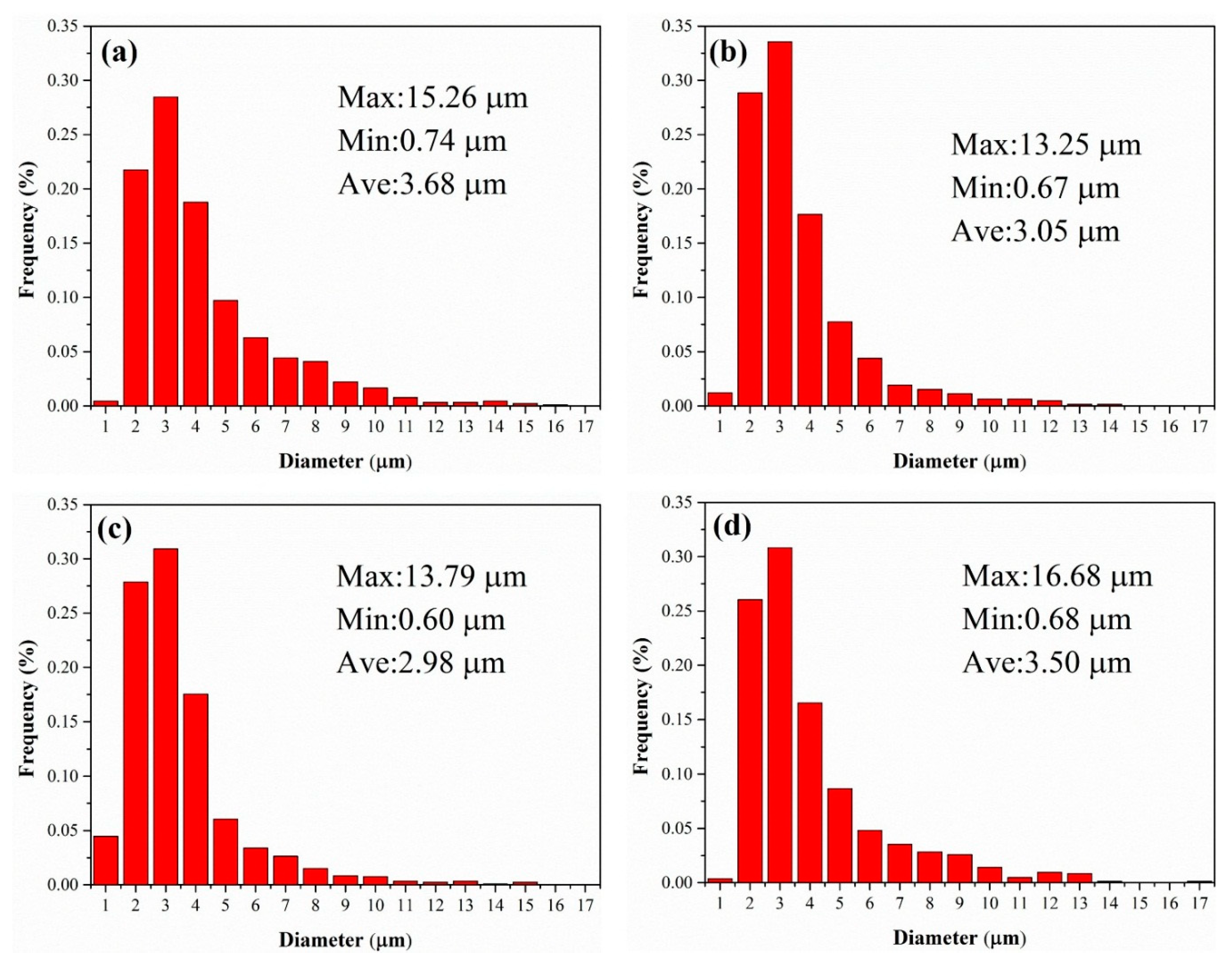
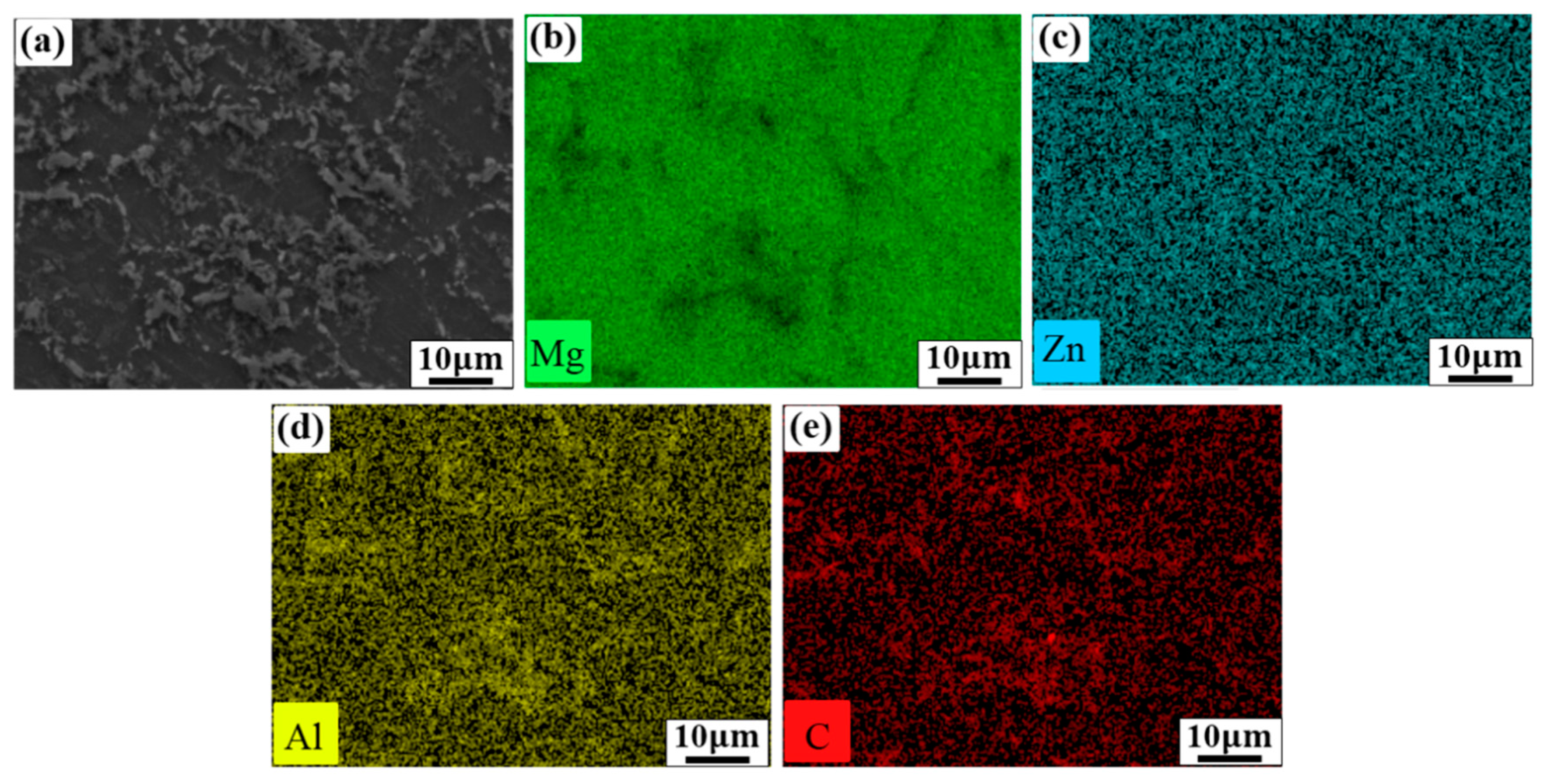
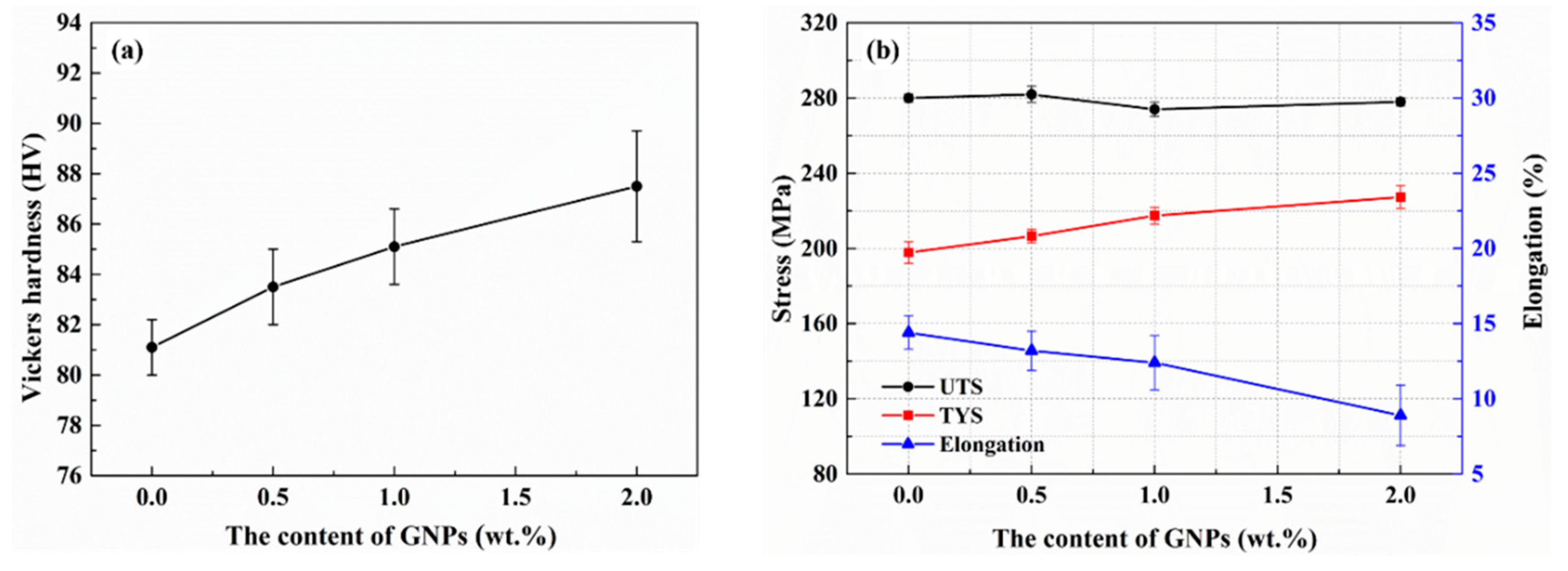
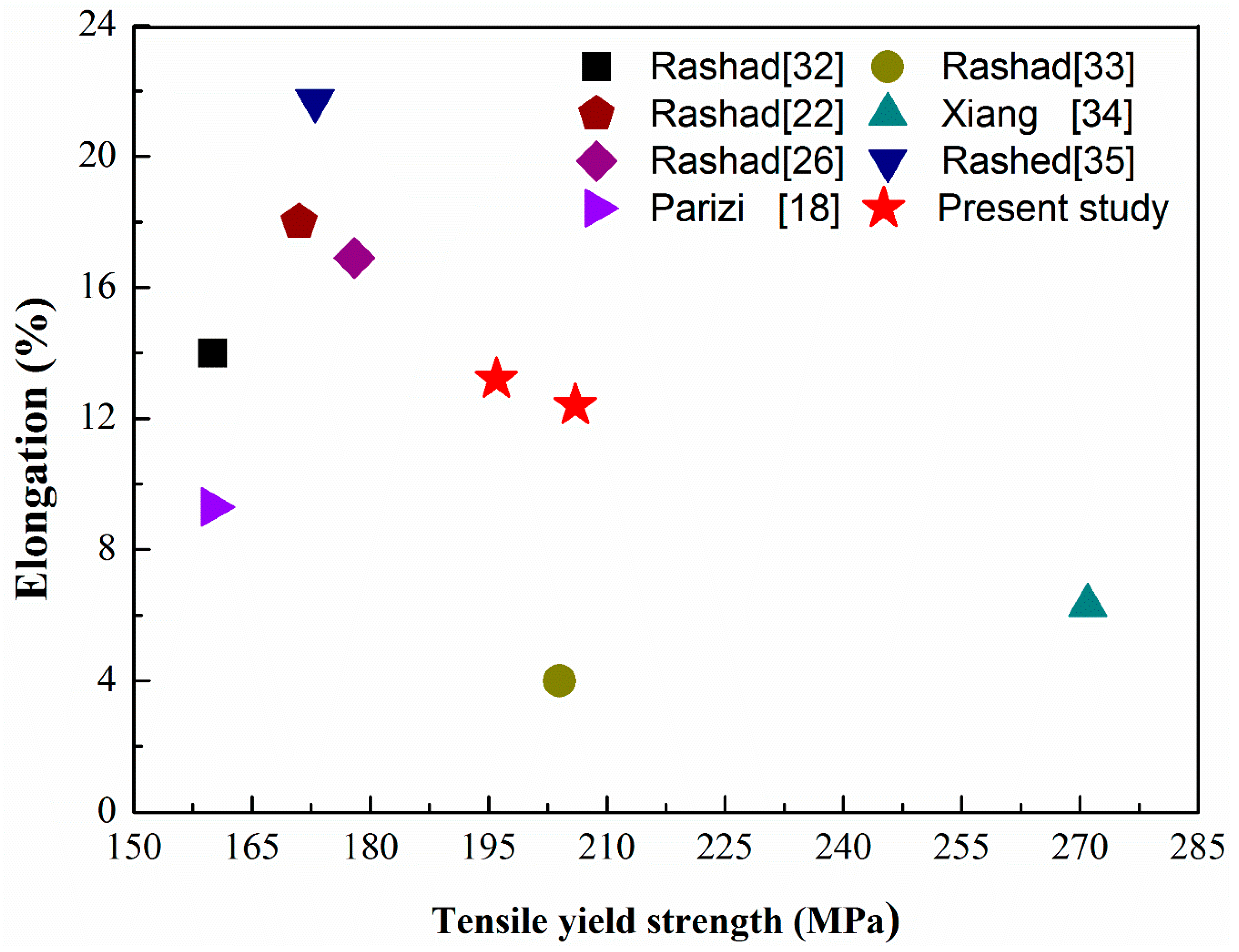
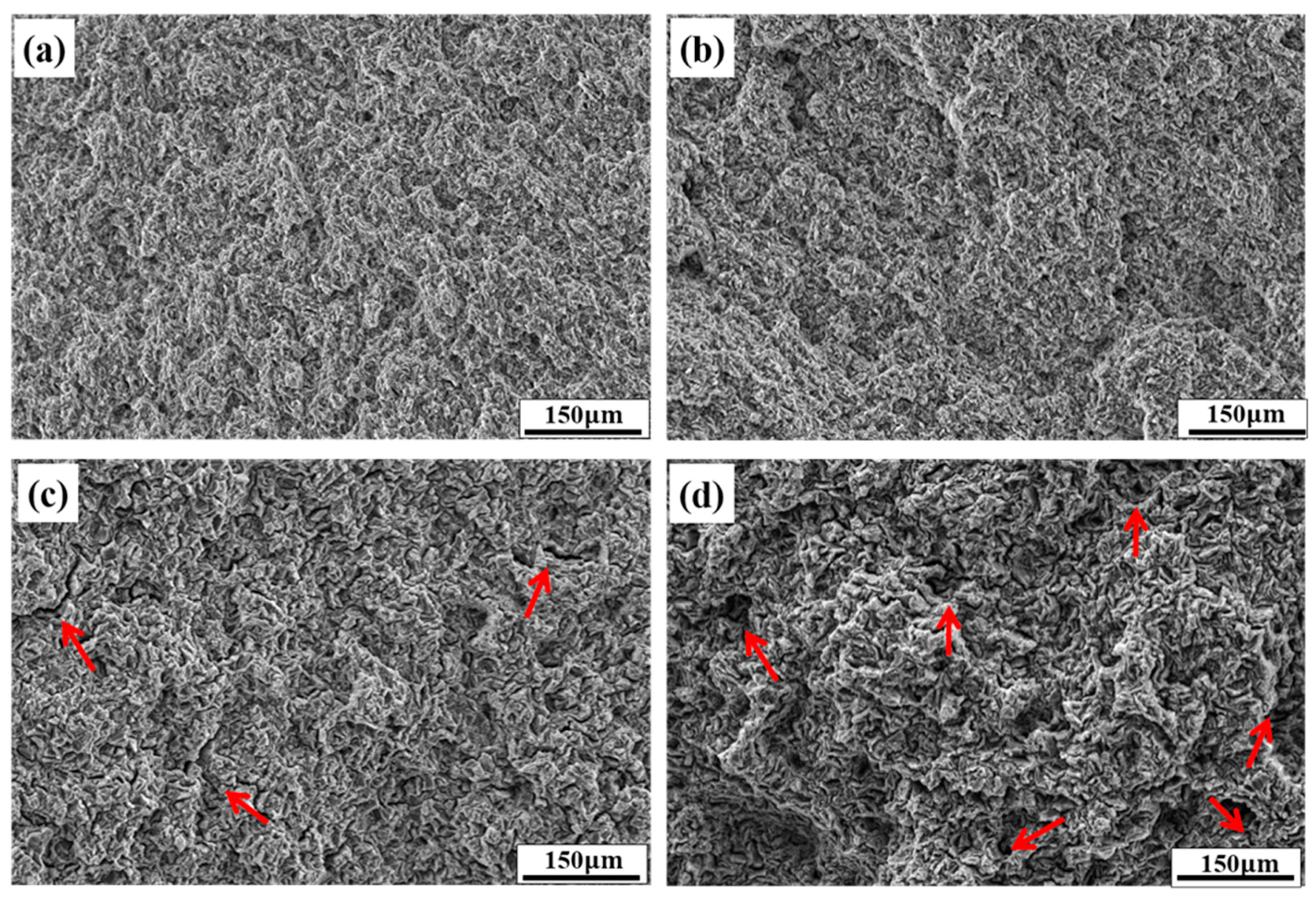
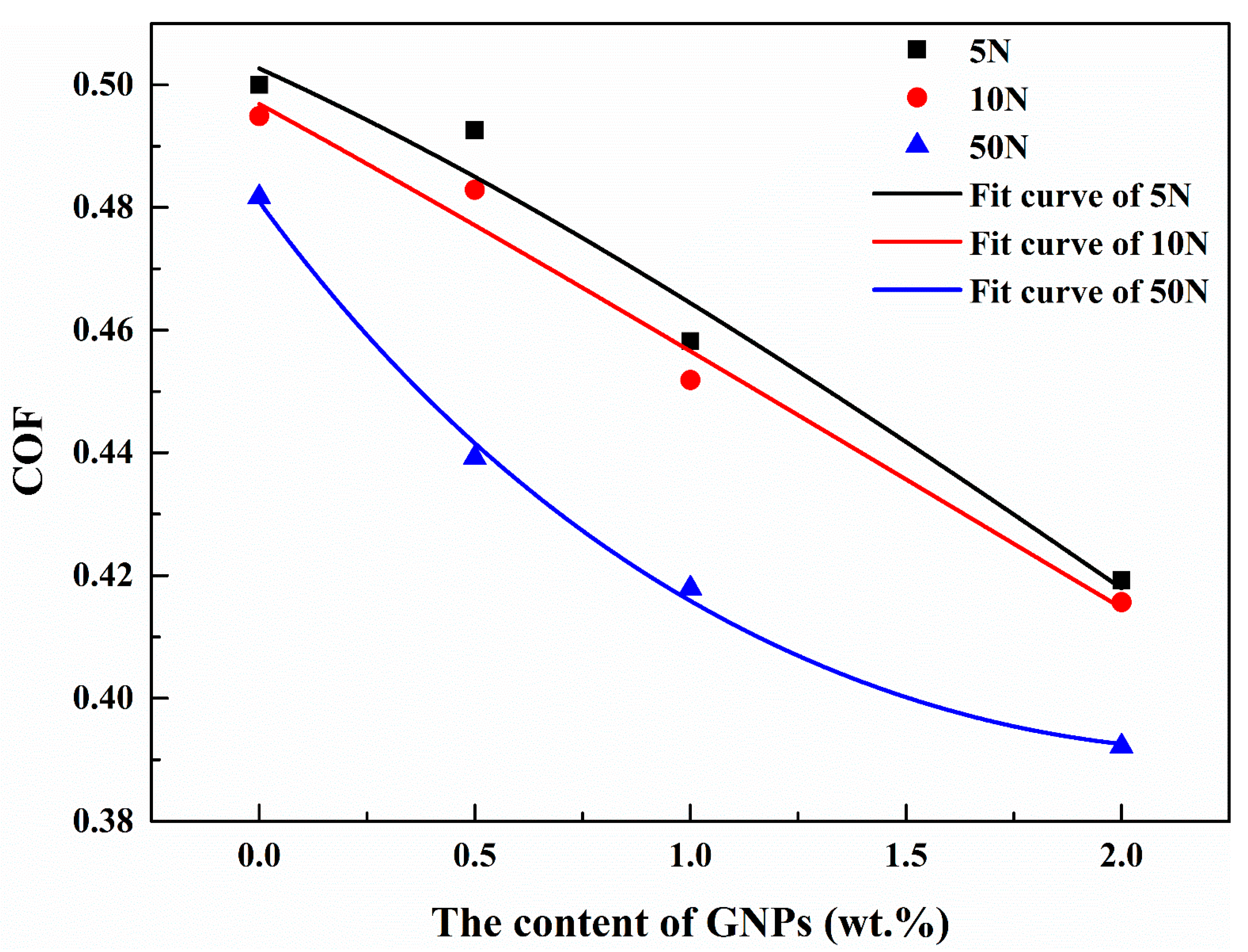


| Materials | Mg | Al | Zn |
|---|---|---|---|
| Purity (%) | >99.9 | >99.8 | >99.8 |
| Particle size (µm) | 45 | 10 | 10 |
| Samples | Theoretical Density (g·cm−3) | Experimental Density (g·cm−3) | Relative Density (%) | Porosity (%) |
|---|---|---|---|---|
| AZ31 | 1.7703 | 1.7637 | 99.63 | 0.37 |
| 0.5GNPs/AZ31 | 1.7724 | 1.7450 | 98.45 | 1.55 |
| 1.0GNPs/AZ31 | 1.7744 | 1.7356 | 97.81 | 2.19 |
| 2.0GNPs/AZ31 | 1.7786 | 1.7150 | 96.42 | 3.58 |
| Samples | Plane | I/Imax | |
|---|---|---|---|
| AZ31 | Basal | 0.10 | |
| Prism | 1.00 | ||
| Pyramidal | 0.67 | ||
| 0.5GNPs/AZ31 | Basal | 0.06 | |
| Prism | 0.99 | ||
| Pyramidal | 1.00 | ||
| 1.0GNPs/AZ31 | Basal | 0.02 | |
| Prism | 0.54 | ||
| Pyramidal | 1.00 | ||
| 2.0GNPs/AZ31 | Basal | 0.02 | |
| Prism | 0.83 | ||
| Pyramidal | 1.00 | ||
| Samples | TYS (MPa) | UTS (MPa) | Elongation (%) | Microhardness (HV) |
|---|---|---|---|---|
| AZ31 | 188 ± 5.2 | 280 ± 2.2 | 14.4 ± 1.1 | 81.1 ± 1.1 |
| 0.5GNPs/AZ31 | 196 ± 3.2 | 282 ± 4.3 | 13.2 ± 1.3 | 83.5 ± 1.5 |
| 1.0GNPs/AZ31 | 206 ± 4.1 | 274 ± 3.8 | 12.4 ± 1.8 | 85.1 ± 1.5 |
| 2.0GNPs/AZ31 | 215 ± 5.5 | 278 ± 2.2 | 8.9 ± 2.0 | 87.5 ± 2.2 |
| No. | Load(N) | Equations | R-Square |
|---|---|---|---|
| 1 | 5 | 0.92 | |
| 2 | 10 | 0.95 | |
| 3 | 50 | 0.99 |
| No. | Load(N) | Equations | R-Square |
|---|---|---|---|
| 1 | 50 | 0.93 | |
| 2 | 10 | 0.93 | |
| 3 | 5 | 0.96 |
© 2020 by the authors. Licensee MDPI, Basel, Switzerland. This article is an open access article distributed under the terms and conditions of the Creative Commons Attribution (CC BY) license (http://creativecommons.org/licenses/by/4.0/).
Share and Cite
Lu, T.; Zhou, M.; Ren, L.; Fan, L.; Guo, Y.; Qu, X.; Zhang, H.; Lu, X.; Quan, G. Effect of Graphene Nanoplatelets Content on the Mechanical and Wear Properties of AZ31 Alloy. Metals 2020, 10, 1265. https://doi.org/10.3390/met10091265
Lu T, Zhou M, Ren L, Fan L, Guo Y, Qu X, Zhang H, Lu X, Quan G. Effect of Graphene Nanoplatelets Content on the Mechanical and Wear Properties of AZ31 Alloy. Metals. 2020; 10(9):1265. https://doi.org/10.3390/met10091265
Chicago/Turabian StyleLu, Tianhui, Mingyang Zhou, Lingbao Ren, Lingling Fan, Yangyang Guo, Xiaoni Qu, Hongtao Zhang, Xianwen Lu, and Gaofeng Quan. 2020. "Effect of Graphene Nanoplatelets Content on the Mechanical and Wear Properties of AZ31 Alloy" Metals 10, no. 9: 1265. https://doi.org/10.3390/met10091265
APA StyleLu, T., Zhou, M., Ren, L., Fan, L., Guo, Y., Qu, X., Zhang, H., Lu, X., & Quan, G. (2020). Effect of Graphene Nanoplatelets Content on the Mechanical and Wear Properties of AZ31 Alloy. Metals, 10(9), 1265. https://doi.org/10.3390/met10091265





